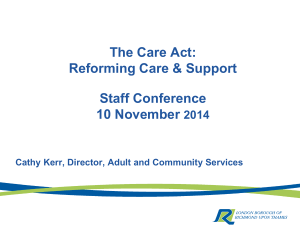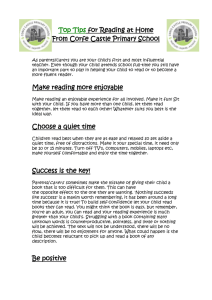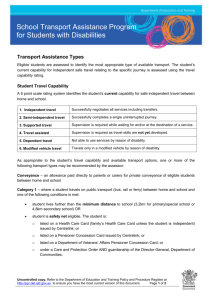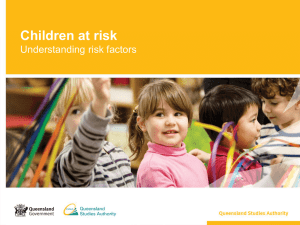Family Resource Survey 2013 - 2014 Carers and Disability
advertisement
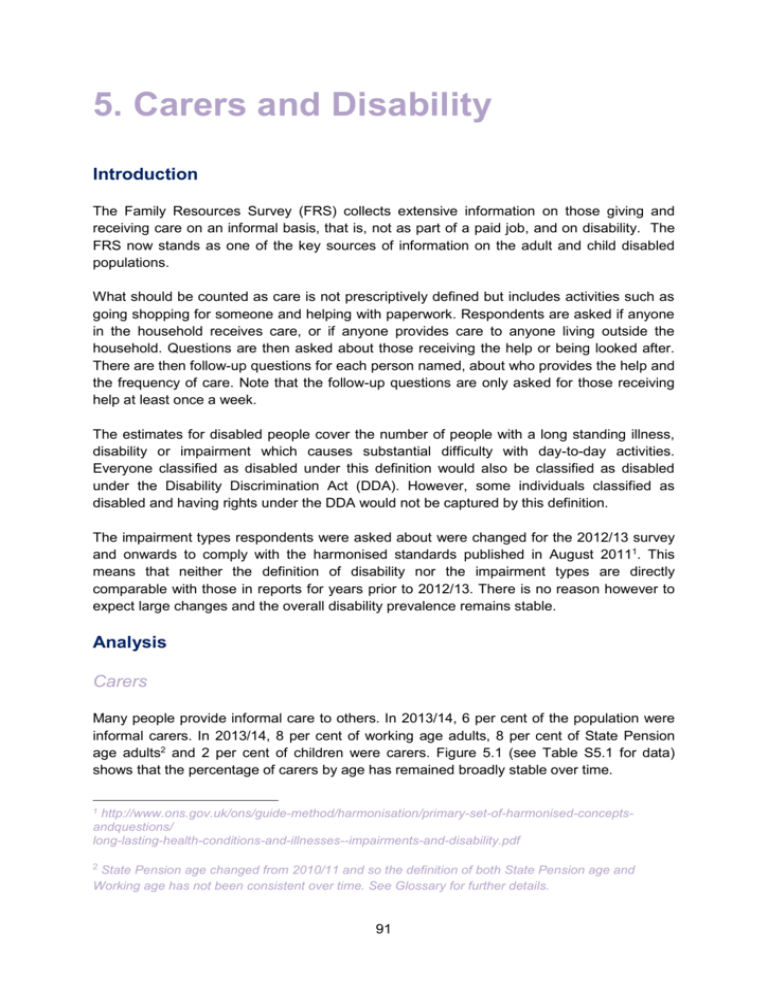
5. Carers and Disability Introduction The Family Resources Survey (FRS) collects extensive information on those giving and receiving care on an informal basis, that is, not as part of a paid job, and on disability. The FRS now stands as one of the key sources of information on the adult and child disabled populations. What should be counted as care is not prescriptively defined but includes activities such as going shopping for someone and helping with paperwork. Respondents are asked if anyone in the household receives care, or if anyone provides care to anyone living outside the household. Questions are then asked about those receiving the help or being looked after. There are then follow-up questions for each person named, about who provides the help and the frequency of care. Note that the follow-up questions are only asked for those receiving help at least once a week. The estimates for disabled people cover the number of people with a long standing illness, disability or impairment which causes substantial difficulty with day-to-day activities. Everyone classified as disabled under this definition would also be classified as disabled under the Disability Discrimination Act (DDA). However, some individuals classified as disabled and having rights under the DDA would not be captured by this definition. The impairment types respondents were asked about were changed for the 2012/13 survey and onwards to comply with the harmonised standards published in August 20111. This means that neither the definition of disability nor the impairment types are directly comparable with those in reports for years prior to 2012/13. There is no reason however to expect large changes and the overall disability prevalence remains stable. Analysis Carers Many people provide informal care to others. In 2013/14, 6 per cent of the population were informal carers. In 2013/14, 8 per cent of working age adults, 8 per cent of State Pension age adults2 and 2 per cent of children were carers. Figure 5.1 (see Table S5.1 for data) shows that the percentage of carers by age has remained broadly stable over time. 1 http://www.ons.gov.uk/ons/guide-method/harmonisation/primary-set-of-harmonised-conceptsandquestions/ long-lasting-health-conditions-and-illnesses--impairments-and-disability.pdf 2 State Pension age changed from 2010/11 and so the definition of both State Pension age and Working age has not been consistent over time. See Glossary for further details. 91 Table 5.1 shows that 46 per cent of adult carers care for less than 20 hours per week. Nineteen per cent of carers report caring for 50 hours or more per week. Percentage of the population (%) Figure 5.1: Prevalence of informal carers from 2003/04 to 2013/14 Children Working age adults State pension age adults All adults All individuals 20 18 16 14 12 10 8 6 4 2 0 Year Number of carers (ooo's) Figure 5.2: Number of carers by gender from 2003/04 to 2013/14 90 Male 80 Female 70 60 50 40 30 20 10 0 Year Figure 5.2 shows that females were more likely to report caring than males. In 2013/14, 59 per cent of individuals who reported caring responsibilities were female, and this has been relatively stable over time. 92 Figure 5.3 Informal carers by relationship to person being cared for Relationship Non-household member Household member Parent Spouse/Civil partner Cohabitee Daughter/Son Sister/Brother Male Other relative Female Non-relative Parent Spouse/Civil partner Daughter/Son Other relative Friend/Neighbour Client of voluntary group Other 0 5 10 15 20 Percentage of informal carers (%) 25 30 Approximately 33 per cent of informal carers in Northern Ireland in 2013/14 were providing care to someone living outside their own household. Table 5.2 and Figure 5.3 show that family members were the main recipients of informal care from both household and nonhousehold members. Figure 5.4 (see table S5.4 for data) shows that many carers balance their caring responsibilities with paid work. Table 5.3 shows that overall 50 per cent of adult carers are in either full-time or part-time employment (employed/self-employed). Of all adult carers fulltime employees and those in retirement made up the largest groups (30 per cent and 23 per cent respectively in 2013/14). The next largest group was those who were part-time employees (13 per cent). In 2013/14, 71 per cent of working age adult carers in employment worked full time while 30 per cent worked part time. 93 Percentage of adults aged below 65 in work (%) Figure 5.4: Adults aged below 65 in work by employment 80 70 Carers 60 All adults 50 40 30 20 10 0 Employee, full time Employee, part time Self employed , full time Self employed , part time Employment Status Figure 5.5 shows that compared to the age distribution of the whole population, the distribution of those receiving care is different, with a higher proportion of those receiving care being over 55 years old. Figure 5.5 also shows that 47 per cent of females receiving care were 65 or over compared to 37 per cent of males. Figure 5.5: Individuals receiving care by age and gender Age Receiving care All individuals Male, % Female, % All, % Male, % Female, % All, % Under 16 12 5 8 22 20 21 16-24 14 3 8 13 12 12 25-34 4 9 7 14 14 14 35-44 9 7 8 13 14 13 45-54 14 14 14 14 14 14 55-64 10 15 13 11 11 11 65-74 16 17 17 8 9 8 75-84 16 21 19 4 6 5 5 9 7 1 2 1 48% 52% 100% 48% 52% 100% 85+ All (=100%) There were large differences in the main sources of household income reported by individuals receiving care and the overall population (Table 5.6); wages and salaries were the main source of income for 25 per cent of individuals receiving care compared with 61 per cent of the population. Similarly ‘Retirement pensions plus any IS/PC’ was the main source of income for 34 per cent of individuals receiving care compared to 10 per cent of the population. These differences likely reflect the older age profile of individuals receiving care compared to the overall population. Eight per cent of those receiving care report disability benefits as the main source of income. 94 Disability Figure 5.6 (see Table S5.5 for data) shows that in Northern Ireland, the proportion of disabled people differed by age group: in 2013/14, 7 per cent of children were disabled compared to 16 per cent of adults of working age and 47 per cent of adults over State Pension age3. The estimated percentage of the population who were disabled remained broadly stable over time at 19 per cent in both 2003/04 and 2013/14, fluctuating between 17 per cent at the lowest level to 20 per cent at the highest level. Figure 5.6: Disability prevalence from 2003/04 to 2013/14 Percentage of the population (%) 60 50 All individuals 40 Children Working age adults 30 State Pension age adults All adults 20 10 0 Year Figure 5.7 (see Table S5.6 for data) shows that in 2013/14; approximately 182 thousand females and 158 thousand males were disabled in Northern Ireland. The disability prevalence estimates by gender remained broadly stable over time. 3 State Pension age changed from 2010/11 and so the definition of both State Pension age and Working age has not been consistent over time. See Glossary for further details. 95 Number of disabled individuals (000's) Figure 5.7: Number of disabled people by gender from 2003/04 to 2013/14 200 Male 180 Female 160 140 120 100 80 60 40 20 0 Year Figure 5.8 provides more detailed information about the types of impairment that disabled people had and shows that the distribution is stable over time. Please note that respondents can be affected by (and can report) more than one type of impairment. The types of impairment respondents were asked about changed for the 2012/13 survey, so the 2011/12 data have been displayed in a separate table. These changes specifically prevent direct comparisons over time, but there is no reason to expect large changes and overall disability prevalence remains stable. In 2013/14, the percentages of the disabled population affected by different impairment types varies widely, ranging from 55 per cent (189 thousand) reporting a mobility impairment to 7 per cent (24 thousand) reporting a social or behavioural impairment. 96 Figure 5.8: Disability prevalence disaggregated by impairment type in Northern Ireland4 2011/12 Impairment type 000's % Mobility 198 64% Lifting, carrying 168 54% Manual dexterity 80 26% Continence 40 13% Communication 51 17% Memory/concentration/learning 66 21% Recognising when in danger 23 7% Physical co-ordination 76 25% Other 92 30% All with at least one impairment 309 2012/13 Impairment type 000's 2013/14 % 000's % Vision 32 9% 33 10% Hearing 35 10% 37 11% Mobility 196 56% 189 55% Dexterity 115 33% 100 29% Learning 36 10% 47 14% Memory 42 12% 59 17% Mental Health 60 17% 69 20% 130 37% 138 41% Stamina/breathing/fatigue Socially/behaviourally 19 5% 24 7% Other 67 19% 46 13% All with at least one impairment 350 341 Disability prevalence estimates by region show that the distribution of disabled people was fairly evenly spread, as shown in Figure 5.9. In 2013/14 Northern Ireland disability prevalence was approximately 19 per cent (0.3 million) of the Northern Ireland population, this level has been relatively constant over the last 10 years and is the same as the UK level. While the vast majority of those in receipt of disability-related benefits have rights under the DDA, not all covered by this act will be in receipt of a disability-related benefit, and not all those in receipt of a disability-related benefit will consider themselves as disabled5. 4 The totals will sum to over 100 per cent as respondents can be affected by (and can report) more than one impairment type and the denominator is the number of disabled people. 5 A survey from 2002 asked disabled respondents whether they considered themselves to be disabled. Overall just under half (48 per cent) said that they did. “‘Disabled for Life?’ attitudes towards, and experiences of, disability in Britain” (2002, DWP): http://webarchive.nationalarchives.gov.uk/20130128102031/http://research.dwp.gov.uk/asd/asd5/repo rt_abstracts/rr_abstracts/rra_173.asp 97 Figure 5.9: Disability prevalence per region (formerly Government Office Region) 2011/12 Millions 2012/13 % Millions 2013/14 % Millions % North East 0.6 25 0.6 25 0.6 23 North West 1.5 22 1.5 22 1.5 21 Yorkshire and the Humber 1.1 21 1.1 21 1.0 19 East Midlands 0.9 20 1.0 22 1.0 21 West Midlands 1.1 21 1.1 20 1.1 20 East of England 1.1 18 1.1 19 1.1 19 London 1.2 15 1.2 14 1.2 15 South East 1.5 17 1.4 16 1.4 17 South West 1.0 20 1.0 19 1.0 19 10.1 19 10.0 19 9.9 19 Wales 0.6 21 0.7 24 0.6 19 Scotland 1.0 20 1.1 21 1.1 21 11.8 19 11.8 19 11.6 19 Northern Ireland 0.3 17 0.4 19 0.3 19 United Kingdom 12.1 19 12.2 19 11.9 19 England Great Britain There were large differences in the main source of income for those individuals with a disability compared to the overall population (Table 5.8); wages and salaries were the main source of income for 32 per cent of individuals with a disability compared to 61 per cent of the population. Similarly ‘Retirement pension plus any IS/PC’ and ‘benefits’ (disability and social security) were the main source of income for 29 per cent and 25 per cent of individuals with a disability respectively compared to just 10 per cent and 13 per cent of the overall population respectively. Notes for Analysis 1. Comparison of the 2013/14 NI FRS data with census (2011) information suggested that the FRS under-reported those giving care. The FRS estimates that 6 per cent of the Northern Ireland population provides unpaid care where as the Census states that 12 per cent of the NI population provides unpaid care. On the FRS, questions are asked as part of the household schedule, and, unlike some other surveys, it is not always the case that the person providing or giving the care is addressed directly. Uses of FRS data, for example the modelling of benefits such as Carer's Allowance, are applicable to those requiring more frequent caring. 2. The means of identifying disabled people has changed over time. From 2003/04, statistics are based on responses to questions about barriers across a number of areas of life. Figures for 2003/04 are based on those reporting barriers across eight areas of life and figures from 2004/05 onwards are based on those reporting barriers across nine areas of life. From 2012/13 disabled people are identified as those who report any physical or mental health condition(s) or illness(es) that last or are expected to last 12 months or more and which limit their ability to carry out day-to-day activities. 98 3. The FRS does not record information on individuals in nursing or retirement homes. This means that figures relating to older people may not be representative of the Northern Ireland population, as many older people may have moved into homes where they can receive more frequent help. However care within nursing homes is likely to be ‘formal’ and is not covered in this chapter or collected by the FRS. Also, therefore it is likely that disability prevalence for older people is higher than estimated from the FRS. 4. All analysis in this section is based on informal carers in NI only i.e. carers who do not provide help as part of a formal job. The terms ‘informal carer’ and ‘carer’ are used interchangeably. 5. Children under the age of 15 sometimes provide informal care. Where these children have been included in analysis of carers a footnote will be provided at the bottom of individual tables. 6. Figures are rounded to the nearest thousand or percentage point and may not sum due to rounding. Alternative Data Sources Administrative sources: Carer’s Allowance claims and Disability related benefits, such as Disability Living Allowance: http://www.dsdni.gov.uk/index/stats_and_research/benefit_publications.htm Survey sources: Census (Key statistics for Health and Social care in Northern Ireland 2011): http://www.ninis2.nisra.gov.uk/public/Theme.aspx?themeNumber=134&themeName= Health and Social Care Detailed Tables Contents and points to note when interpreting tables Tables 5.1 to 5.6 provide analysis on those giving and receiving care, while Tables 5.7 and 5.8 provide analysis on those with disabilities. Tables 5.1 to 5.4 look at those providing care. Carers are counted only once, even if they look after more than one individual. Carers outside the household are not included in these tables as they are not identified individually within the questionnaire, and they may also produce instances of double counting. Table 5.1 provides analysis of adult informal carers by gender, age and number of hours of care provided per week; the overall sample size available is quite small and therefore these findings should be treated with caution. Table 5.2 looks at the gender of the carer and their relationship with the person being cared for. Those giving care to more than one person have been combined into one group. For non-household members, more than one person receiving care means more than one entry 99 in either the ‘relative’, ‘friend/neighbour’, ‘client of voluntary organisation’ or ‘other nonhousehold’ group. However, if someone cared for more than one ‘friend/neighbour’, for example, this would not be picked up by the questionnaire. Tables 5.3 and 5.7 use the International Labour Organisation (ILO) definition of employment which is harmonised with other government surveys. The employment status categories for student, looking after family/home and temporarily sick/injured are aggregated with ‘other inactive’. Tables 5.4 and 5.6 show the main source of income received by the households in which the carer and the person being cared for live, by gender. ‘Main source’ is calculated as the category of income that gives the highest amount and results should be interpreted with caution since some households may have more than one source that provides similar proportions. Tables 5.5 and 5.6 look at household members receiving care. An individual is recorded as receiving care if they receive care from another person in the household and/or from someone outside the household. They are counted only once no matter how many people provide care to them. The number of FRS sample respondents receiving care is lower (254) than the number of FRS sample respondents providing care (285) This will be, in part, because many recipients of care, received help from more than one person within their household, each of whom was recorded as a separate carer. Table 5.8 provides analysis based on individuals with a disability and looks at the main source of income by gender. Key definitions used Please refer to the Glossary for definitions of the key terms used in this section. Changes to tables between 2012/13 and 2013/14 Prior to 6 April 2010, women reached State Pension age at 60. From 6 April 2010, the qualifying age for women has been gradually increasing. FRS data contained in this report was collected throughout the financial year 2013/14, during which the State Pension age for women increased from 61 years and 5 months to 62 years 0 months. The changes do not impact on the State Pension age of men, currently 65. This change affects Figures 5.1 and 5.4. 100 Table 5.1: Adult informal cares by gender, age and number of hours per week providing care Percentage of informal carers Age Less than 5 hours 5 but less 20 but less 35 but less Varies, less than 20 than 35 than 50 50 or more than 35 hours hours hours hours hours Hours per w eek Varies, more than Sample Size 35 hours Unknow n (=100%) All carers 16-44 .. .. .. .. .. .. .. .. 91 45+ 12 30 13 11 18 5 10 - 174 All male carers 27 26 9 9 16 5 7 0 106 All female carers 10 31 14 11 21 5 9 1 159 All adult carers 17 29 12 10 19 5 8 - 265 101 Table 5.2: Informal carers1 by relationship to person being cared for and whether living in or outside the household Percentage of informal carers Carers Person being cared for Male Female All inform al carers Household m em ber Parent 10 9 10 Spouse/civil partner 28 19 23 Cohabitee 4 1 3 Son/Daughter 18 24 22 Brother/Sister 1 5 3 Other relative 0 0 0 Non-Relative 0 1 - Parent 27 25 26 Partner 1 0 - Son/Daughter 2 2 2 Other relative 4 4 4 Friend/neighbour 2 - 1 Client of Voluntary Group 0 1 - Inside of Household 1 4 3 Outside of Household 1 2 1 Both inside and outside of Household 1 2 2 106 159 265 Non household m em ber More than one person Sample Size (=100%) 1 Includes children aged 15 and under 102 Table 5.3: Adult informal carers by employment status and gender Percentage of adults Employment status Adult Carers All Adults Male Female All adult carers Full-time Employee 42 21 30 47 32 39 Part-time Employee 4 19 13 5 19 12 Full-time Self-Employed 7 1 4 11 2 7 Part-time Self-Employed 2 3 3 1 1 1 ILO unem ployed 3 2 2 6 3 5 Retired 23 23 23 17 24 21 Student 0 0 2 3 2 Looking after fam ily/hom e 3 12 8 1 7 4 Perm anently sick/disabled 4 13 9 7 7 7 Tem porarily sick/injured 1 0 - - 1 - 10 6 8 2 2 2 106 159 265 1,583 1,764 3,347 Male Female All adults Em ployees Self-em ployed Other Inactive Sample Size (=100%) 103 1 Table 5.4: Informal carers by gender, main source of total weekly household income and hours caring Percentage of informal carers Main source of household income Number of hours per w eek Less than 20 or more 20 hours hours Varies Wages and salaries Gender Male All Female carers 65 50 .. 55 54 54 Self employment income 4 1 .. 3 2 2 Investments - 0 .. 0 - - Tax Credits Retirement Pension plus any IS / Pension Credit 2 - .. 2 2 2 8 16 .. 18 12 15 10 5 .. 7 8 8 Other pensions Social Security - disability benefits 1 5 .. 1 5 3 Other Social Security benefits 9 23 .. 16 16 16 Other sources 0 - .. 0 - - 124 126 34 113 172 285 Sample Size (=100%) 1 Includes children aged 15 and under 104 Table 5.5: Individuals receiving care by gender, age and frequency of care Percentage of individuals Age Frequency of care received Several Several Once or times a Continuously times a day tw ice a day w eek Once a w eek Sample Size (=100%) All individuals receiving care 0-64 43 30 14 6 7 141 65+ 34 23 21 16 6 113 All m ales receiving care 37 33 15 9 6 119 All fem ales receiving care 40 23 19 11 7 135 All individuals receiving care 39 27 17 10 6 254 105 Table 5.6: Individuals receiving care by main source of total weekly household income and gender Percentage of individuals Receive Care Main source of household income Wages and salaries All Individuals Male Female All receiving care Male All Female individuals 27 24 25 63 60 61 Self employment income 1 1 1 8 5 6 Investments 0 0 - - - Tax Credits 3 - 2 3 3 3 32 37 34 9 12 10 8 6 7 5 6 5 Retirement Pension plus any IS / Pension Credit Other pensions Social Security - disability benefits Other Social Security benefits Other sources Sample Size (=100%) 8 9 8 1 1 1 21 23 22 11 12 12 1 0 - 1 1 1 119 135 254 2,264 2,438 4,702 106 Table 5.7: Adults with a disability, including limiting long standing illness by employment status and gender Percentage of adults Employment Status Adults w ith a disability All adults w ith a Male Female disability All adults Male Female All adults Em ployees Full-time 14 7 10 47 32 39 Part-time 3 7 5 5 19 12 Full-time 3 1 2 11 2 7 Part-time 2 2 2 1 1 1 ILO Unem ployed 5 2 3 6 3 5 Retired 39 49 44 17 24 21 Student 1 - - 2 3 2 Looking after fam ily/hom e - 3 2 1 7 4 Perm anently sick/disabled Self-em ployed 31 26 29 7 7 7 Tem porarily sick/injured - 2 1 - 1 - Other Inactive 1 1 1 2 2 2 359 441 800 1,583 1,764 3,347 Sample Size (=100%) 107 Table 5.8: Individuals with a disability including limiting long standing illness by main source of total weekly household income and gender Percentage of individuals Main source of household income Wages and salaries Individuals w ith a disability All w ith a Male Female disability All Individuals Male All Female individuals 35 29 32 63 60 61 Self employment income 2 2 2 8 5 6 Investments 0 - - - - - Tax Credits Retirement Pension plus any IS / Pension Credit Other pensions Social Security - disability benefits Other Social Security benefits Other sources Sample Size (=100%) 2 1 2 3 3 3 25 32 29 9 12 10 8 10 9 5 6 5 5 4 4 1 1 1 22 21 21 11 12 12 1 - 1 1 1 1 418 484 902 2,264 2,438 4,702 108 Section 5 Supplementary tables S5.1- Data for Figure 5.1: Prevalence of informal carers from 2003/04 to 2013/14 S5.2- Data for Figure 5.2: Number of adult carers by gender from 2003/04 to 2013/14 S5.3- Data for Figure 5.3: Informal carers by relationship to person being cared for S5.4- Data for Figure 5.4: Adults aged below 65 in work by employment status S5.5- Data for Figure 5.5: Disability prevalence from 2003/04 to 2013/14 S5.6- Data for Figure 5.6: Number of disabled people by gender from 2003/04 to 2013/14 109 Table S5.1: Prevalence of informal carers from 2003/04 to 2013/14 Percentage of population Age group Year Working age adults Children State pension age adults All adults All individuals Sample size (=100%) 2003/04 1 10 10 10 8 4,691 2004/05 0 9 7 8 6 4,810 2005/06 1 9 8 9 7 4,635 2006/07 1 9 9 9 7 4,522 2007/08 1 10 10 10 8 4,397 2008/09 0 8 10 9 7 4,563 2009/10 1 8 9 8 6 4,794 2010/11 1 9 9 9 7 4,492 2011/12 1 7 8 7 6 4,609 2012/13 1 8 7 8 6 4,461 2013/14 2 8 8 8 6 4,702 Table S5.2: Number of carers by gender from 2003/04 to 2013/14 Percentage of carers Gender year Male, 000's Male, % of carers Female, 000's Female, % of carers Sample size (=100%) 2003/04 51 40 78 60 337 2004/05 40 38 65 62 293 2005/06 50 42 70 58 316 2006/07 46 38 74 62 309 2007/08 53 40 80 60 323 2008/09 52 45 65 55 291 2009/10 44 39 67 61 293 2010/11 47 39 72 61 284 2011/12 38 37 64 63 254 2012/13 40 37 69 63 253 2013/14 47 41 68 59 285 110 Table S5.3: Informal carers by relationship to person being cared for Percentage of individuals w ho are carers Gender Relationship Household member Non-household member Male Female Parent 10 9 Spouse/Civil partner 28 19 Cohabitee 4 1 Daughter/Son 18 24 Sister/Brother 1 5 Other relative 0 0 Non-relative . 1 Parent 27 25 Spouse/Civil partner 1 . Daughter/Son 2 2 Other relative 4 4 Friend/Neighbour 2 0 Client of voluntary group . 1 Other .. - 113 172 Sample size (=100%) Table S5.4: Adults aged below 65 in work by employment status Percentage of w orking adults aged under 65yrs in employement Employment status Carers All adults Employee, full time 63 68 Employee, part time 25 20 Self employed , full time 8 10 Self employed , part time 5 1 All full time w orkers 71 78 All part time w orkers 30 21 Sample size (=100%) 123 111 1,836 Table S5.5: Disability prevalence from 2003/04 to 2013/14 Percentage of individuals Age group 2003/04 2004/05 2005/06 2006/07 2007/08 2008/09 2009/10 2010/11 2011/12 2012/13 2013/14 19 17 20 18 17 18 17 17 17 19 19 All individuals Children 5 5 5 5 4 5 6 5 7 7 7 Working age adults 16 15 18 15 14 15 14 15 14 17 16 State Pension age adults 52 46 50 47 47 48 46 48 45 46 47 All adults 24 22 24 22 21 22 21 21 21 23 22 Sample size (=100%) 4,691 4,810 4,635 4,522 4,397 4,563 4,794 4,492 4,609 4,461 Table S5.6: Number of disabled people by gender from 2003/04 to 2013/14 Number of individuals (000's) Gender 2003/04 2004/05 2005/06 2006/07 2007/08 2008/09 2009/10 2010/11 2011/12 2012/13 2013/14 Male 146 138 161 143 136 145 153 150 142 170 158 Female 167 157 174 157 155 167 155 157 167 180 182 Sample size (=100%) 912 849 951 855 804 872 879 835 839 915 902 112 4,702


